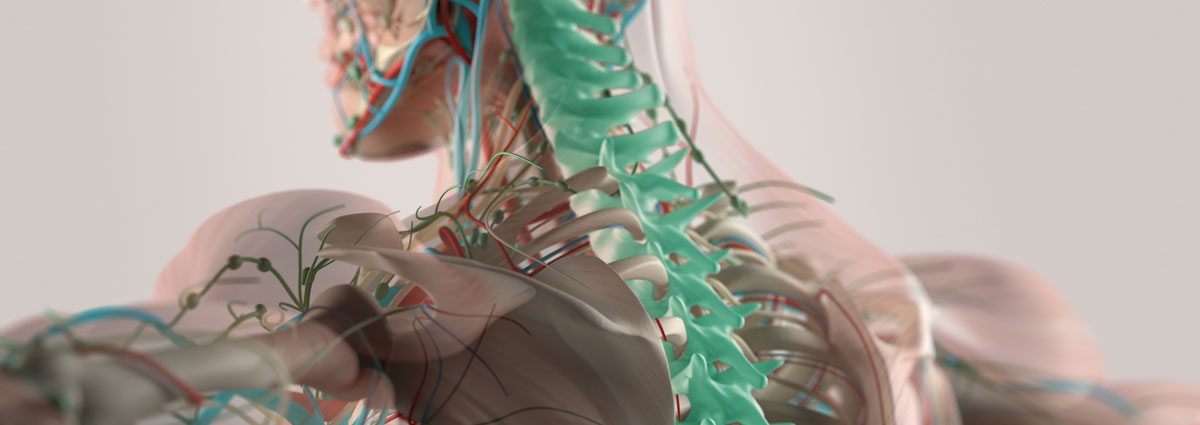
Spinal column
The main function of the spine is to support the body and protect the nerve structures it surrounds. The most common conditions treated by spine specialists are related to:
- Cervical pain. The cervical spine, which provides mobility to the patient, is located at the top of the spinal column. The pain may sometimes be accompanied by a variety of symptoms, including tingling in the fingers or dizziness.
- Lower back pain is pain that occurs in the lower back and is often referred to as lumbago.
- Scoliosis. It occurs when there is a deviation of the spine.
- Vertebral fracture (with or without compression). A fracture of one of the bones in the spine can be caused by trauma or an accident, although a significant number of cases are related to osteoporosis.
The expertise of a spine specialist is key in treating these conditions.
In any treatment, it is essential to assess the experience and qualifications of the team of specialists who will be treating you. Centro Médico Teknon has renowned spine specialists capable of providing a full range of top-level spinal surgery techniques.
The centre is equipped with state-of-the-art technology, which allows surgeons to accurately locate the lesion to be treated in the operating theatre, enabling greater precision and achieving more optimal clinical results. The centre is also a pioneer in navigation-guided surgery.
The centre's excellence in all medical and healthcare procedures and treatments has been recognised by the renowned Joint Commission International. This seal, one of the most important internationally, guarantees the highest quality, safety and precision in all treatments. Centro Médico Teknon is currently one of the few centres to have this distinguished accreditation.
- What causes spinal pathologies?
In most cases, around 80%, spinal pathology has a degenerative origin. The remaining cases (20%) are usually caused by trauma or are related to congenital abnormalities.
Pain and instability are the main symptoms associated with these conditions.
- What diagnostic tests are performed?
After the consultation, during which the specialist will examine you and fill out your medical history, they may request a conventional X-ray to see how your vertebrae are behaving and detect any abnormalities.
It can be supplemented with a more precise examination such as an MRI or CT scan.
- When is surgery necessary?
In cases of degenerative disease, surgery is the last resort. Firstly, the possibility of conservative treatment should be considered, which can range from physiotherapy to relax the muscles and improve mobility, to postural hygiene measures, the use of local heat, or the administration of analgesic drugs or injections.
When the disease has progressed and other treatments are not effective, or when there are neurological deficits, the specialist may recommend surgery.
The patient should be aware at all times of the available treatments and participate in decision-making alongside the specialist.
- What surgical techniques are available?
Broadly speaking, there are different surgical techniques, depending on the pathology. Thanks to the development and emergence of new systems, techniques are becoming less invasive, reducing wound size and surgical risks:
- Open techniques (classic)
- Minimally invasive techniques
- Percutaneous endoscopic surgery
- Microsurgical surgery with minimal incision
In recent years, open techniques have tended to be minimised, with less aggressive surgery through the use of different technological advances, including navigation-guided surgery.
- What is navigation-guided surgery?
Navigation-guided surgery is performed with the help of a computer programme which, using a CT scan and an X-ray of the patient, creates 3D images of the spine, allowing the specialist to perform the surgery with excellent precision.
In cases where this system is used, the patient undergoes a CT scan in the Diagnostic Testing Department as well as an X-ray (front and side view) in the operating theatre. With both tests, the computer system composes a 3D image of the actual moment when the operation begins.
Using specific instruments and laser cameras recognised by the computer programme, the specialist can perform the surgery more precisely and accurately, placing the screws with a margin of error of less than 1.5 mm, in other words, with 99.5% accuracy.
- What happens after the procedure?
Following the procedure, the patient remains in the medical centre for between 24 hours and 3 days. During the first few days, patient should avoid excessive exertion and pay attention to his or her posture. After the period determined by the specialist, the patient must undergo rehabilitation and/or physiotherapy to recover physically and strengthen muscles.
The time it takes to return to work will depend on the patient, the condition and the type of work he/she does. This may take up to between one and five months.


































